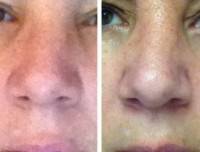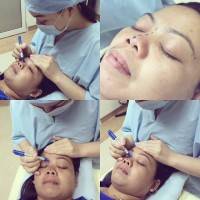Rhinoplasty Implants
Most experts in augmentation rhinoplasty do not use any synthetic material because of higher complications.
In New York, we use your own diced cartilage wrapped in temporal fascia. You need a graft that will last a lifetime. (George J. Beraka, MD (retired), Manhattan Plastic Surgeon)
Goretex vs Silicone rhinoplasty Implants in Asian Nose
I have seen Silicone extrusion more frequently than goretex. The shrinkage of goretex is not a big issue. Its unlikely that it will shrink by 40%.
It will give you the height you need and for small base you might need wedge excisions of the alar areas. (Tanveer Janjua, MD, Bedminster Facial Plastic Surgeon)
Synthetic materials for augmentation rhinoplasty
I prefer autogenous material for rhinoplasty. The benefits of any of the synthetics are that it is easy for the surgeon, the operative time is less, and there is no donor site morbidity.
The down side is fairly significant – these synthetic materials can get infected and need to be removed, and they can extrude.
It is more work for the surgeon to use autogenous materials and costs more to the patient, but in the long term you will have less problems. Septal cartilage is first choice (no second site morbidity), and then either ear or rib cartilage depending on how much augmentation you desire.
Keep doing your research looking at long term problems with synthetics before moving forward. (Michael A. Bogdan, MD, FACS, Dallas Plastic Surgeon)
Goretex/Silicone implants for Rhinoplsty
You do not state what problem you are trying to address with Goretex or Silicone Implants, but I assume that you want an augmentation of some sort for a depression. Although these synthetic substances have been used quite extensively, silicone more so, they do carry higher risks.
Using your natural tissues (such as ear cartilage, fascia, etc) may be a safer alternative, but in order for you to make a wise decision you should seek out an experienced surgeon who does all of these and ask what his/her recommendation would be for your particular problem. Don’t be afraid to ask questions.
Why do you recommend one over the other? What are the relative risks? If a problem opccurs can you fix it and what would it take surgically and what would the costs be AND do I compromise the end result. The more information you have before you do this the better informed you will be and better prepared for the surgery. (Theodore Katz, MD, FACS, Philadelphia Plastic Surgeon)
Implants for asian rhinoplasty
Both Gore-Tex and silicone have been used successfully for many years in rhinoplasty. The positive is that they don’t require a donor site, there is usually reduced operative time (because there is no need to harvest), and they don’t warp. The negatives are that they can become infected and/or extrude. this can happen with either Gore-Tex or silicone Implants and can happen even years later.
Gore-Tex integrates into the tissue which makes it feel a little more like your own tissue, but it also makes it much more difficult to remove if there is a problem. I prefer to use your own cartilage when possible as there is far less of a risk of infection or extrusion.
Cartilage can be taken from the septum, ear, or rib depending on the amount and strength needed. See a rhinoplasty specialist who can discuss your goals and from there lay out your options. (Sirius K. Yoo, MD, San Diego Facial Plastic Surgeon)
Dorsal augmentation with autologous cartilage
A frequent goal during rhinoplasty for Asian patients is increasing the height of the dorsum (dorsal augmentation). This gives better definition of the bridge from the frontal view and a fuller, higher appearing bridge from the lateral view. Implants made from various materials including silicone and Gore-Tex Implants are used frequently for dorsal augmentation as they are generally convenient and quick to use during surgery.
However, implants in the nose are associated with complications including infection and extrusion (pushing out through the skin) both necessitating removal. Additionally, these implants can twist and warp over time which is a frequent reason why patients prevent for revision rhinoplasty. There are ways to perform dorsal augmentation with your own cartilage from inside your nose (septal), the cup of your ear (conchal) or a small piece of rib cartilage.
These pieces of cartilage can be shaped and placed along the dorsum instead of an implant. Although this is technically more demanding and can take slightly longer during surgery to perform than an implant, the results appear to be better longterm as the risk of infection and extrusion are significantly less than with implants. Rhinoplasty surgeons that are experienced with using your own cartilage for dorsal augmentation can perform this procedure efficiently with consistent results. Additionally, there is a technique that combines both your own cartilage and fascia (temporal fascia is a piece of tissue just above the ear under the scalp skin) called diced cartilage-fascia that can be used for dorsal augmentation. Using this technique, it is possible to achieve significant dorsal augmentation but the risk of twisting, warping, or irregularities of the dorsum longterm appears to very low. Patients considering rhinoplasty for dorsal augmentation should give strong consideration to finding a surgeon that is experienced using autologous cartilage for dorsal augmentation. (Jamil Ahmad, MD, Toronto Plastic Surgeon)
The Use of Non-Autologous Tissue in Rhinoplasty
In general, it is highly unadvisable to use non-autologous material like Gore-Tex or silicone implants in rhinoplasty as the long term effects for infection and exposure are not insignificant.
However, in some ethnic populations such as in Asia it is very popular to use a silicone implant. When it is placed deep in the subcutaneous tissue away from the tip, it can last a long time.
However, I do not do this procedure. I would prefer to do a nasal dorsal augmentation with the patient’s own ear or rib cartilage or use an injection of hyaluronic acid filler which is biodegradable over a couple of years. (Rod J. Rohrich, MD, Dallas Plastic Surgeon)
Nasal rhinoplasty implants
Whether one uses gortex or silicone, there is a risk of using synthetic implants for dorsal nasal augmentation.
Autologous tissue like your own rib cartilage or nasal cartilage are better options for dorsal augmentation. (Steven Wallach, MD, Manhattan Plastic Surgeon)
Gore-Tex (ePTFE) rhinoplasty implants work well for implantation on the nasal bridge
Today, Gore-Tex does not supply grafting material for the nose. I have used Surgiform (also ePTFE), with good success, but it is stiffer to work with.
I only use ePTFE to augment the bridge, and I think it works well with a complication rate of less than 5%.
Silicone elastomers (rubberized silicone implants) have a higher likelihood of eventual extrusion. I wouldn’t use either implant in the nasal tip. You should discuss your options with a board-certified, experienced Rhinoplasty surgeon with many favorable photos before proceeding.
I attached a photo of Surgiform ePTFE in the nasal bridge for your perusal. (Eric M. Joseph, MD, West Orange Facial Plastic Surgeon)
Prosthetic materials vs your own tissues
If you are entertaining having prosthetic materials placed in your nose, I will assume that you are trying to build up an area like the bridge. This is commonly done in Asian patients who often lack enoiugh of a bridge from the side view. These materials can work well but can also get into troubles like infection and exposure which require their removal.
Surgeons experienced in rhinoplasty can also augment areas of the nose using your own tissues such as cartilage from the nasal septum, the bowl of the ear, or rib cartilage. Typically, the most experienced surgeons stay away from the prosthetic materials so that should tell you something about their safety. (Richard P. Rand, MD, FACS, Seattle Plastic Surgeon)
Silicon or goretex in nose? be cautious
I only use natural materials – the patients own cartilage. There are certainly patients out there with silicon or other materials placed in a rhinoplasty that are happy with their outcomes (such as building up the bridge).
However, I believe that the risks are higher than using “autologous” materials, that is, your own natural tissue. These risks include infection. My recommendation in all cases is to use natural autologous material. (Patrick Byrne, MD, Baltimore Facial Plastic Surgeon)
I like your own tissue – either septal cartilage or ear cartilage. I have used silicone, and have often had to remove it. Gortex is also not ideal. If you have an infection – it is almost impossible to remove. There is also rib cartilage if you need more than what is in your ear or nose. Stay away from alloplastic materials. (William B. Rosenblatt, MD, New York Plastic Surgeon)

